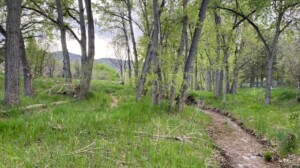Major cities in the United Kingdom such as London and Newcastle have adopted a gentler approach to flood resilience—harnessing features of the existing landscape instead of erecting fortifications.
This ethos is embodied on King’s Road, an artery of Newcastle University in the Northeast of England, where permeable paving absorbs, filters and stores rainwater, while rainwater planters re-emit this moisture into the atmosphere through evapotranspiration. Green roofs throughout the campus pull double duty, moonlighting as absorbent surfaces that reduce rainwater runoff and the carbon footprint while insulating the building against heat loss.
Also a feature of the Herne Hill Highline Project in south London, where 22 green roofs run parallel to the River Effra, they have prevented flash floods that used to inundate the sewers and snarl local drainage systems.
The New Derbyshire Pocket Park in Bethnal Green, London, is flood-proofed by virtue of a sustainable urban drainage system that slows surface water run-off through retention and storage, while bespoke planters dotted throughout the park also capture rainwater.
In some cases, leaving nature to its own devices—with a few corrective prods from a landscape architect—is best. Built on the floodplain of the River Thames, the Barking Riverside development, which consists of 10,000 new homes, office spaces, schools and more, has relinquished part of the land to the river—better to be safe than sorry. Meanwhile, the flood-conscious landscaping provides areas for recreation, picnic zones, community gardens, and walking trails. All surface water run-off in the area is channeled towards the parkland to prevent river overflow, and is incrementally discharged into the creeks at low tide.
Also in London, formerly flood-prone Church Street and Paddington Green have been primed to fend off rainfall greater than the volume of an Olympic-sized swimming pool with a 500 percent increase in trees and the installation of a rain garden, in which select plant species are configured for optimal soil infiltration to reduce run-off.










